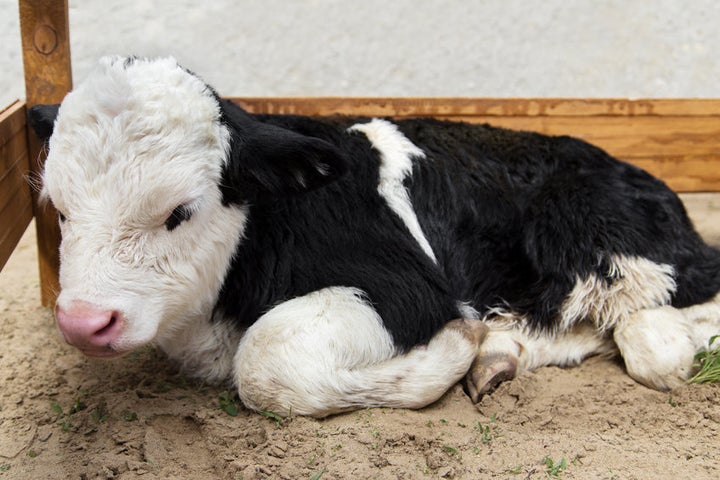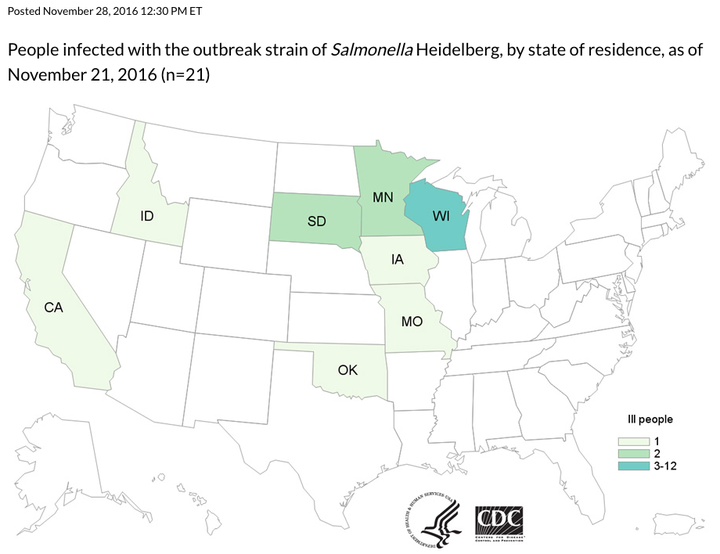
A salmonella Heidelberg outbreak sickened 21 people this year, landing eight of them in the hospital, according to the U.S. Centers for Disease Control and Prevention. The strain of salmonella identified in the outbreak shows signs of multidrug-resistance, making the infections riskier than normal for people who get them.
Dairy bull calves from Wisconsin are the suspected culprit. The calves in question are raised for meat but were also purchased for projects for 4-H, a nationwide youth-focused program that involves children and young adults in hands-on agricultural work.
The outbreak spanned eight states ― California, Iowa, Idaho, Minnesota, Missouri, Oklahoma, South Dakota and Wisconsin ― between January and October. This is the seventh Salmonella outbreak in 2016. Previous CDC investigations this year have identified sprouts, nuts, poultry, egg shells and milkshake mixes as sources for past Salmonella outbreaks.

Of the 19 sickened people interviewed by investigators so far, 15 reported direct contact with these dairy bull calves or other kinds of cattle. Some also reported that they first started coming down with symptoms after their dairy bull calf got sick or died. The patients range in age from less than a year old to 72 years old, with a median age of 21.
In general, salmonella symptoms include diarrhea, fever and abdominal cramping. Symptoms start about 12 to 72 hours after the infection begins, and almost all of the estimated 1.2 million annual infections (most of which can’t be traced to a single source) clear up without treatment after four to seven days. However, people with severe diarrhea may need to be hospitalized, and yearly, about 450 people will die of this infection.
Multidrug-resistant microbes like the bacteria involved in this outbreak are on the rise in the U.S. Each year, at least two million people get infections that are resistant to treatment, and of those, an estimated 400,000 will become sickened by antibiotic-resistant bacteria from the food supply.
Animals in the food supply are fed antibiotics for several reasons, including helping them gain weight with less food. But because these antibiotics can encourage the growth of drug-resistant bacteria, the Food and Drug Administration is leading a voluntary plan to stop using some antibiotics to raise livestock. The CDC is also asking more state labs to test salmonella isolates for drug resistance and use genetic sequencing to identify outbreaks when they happen.
For this particular outbreak, the CDC was able to identify the sickened through PulseNet, a network of labs that perform DNA “fingerprinting,” or genome sequencing, on bacteria that are cultured from sick people. Because of this, the investigators saw that all 21 cases were closely genetically related to each other, which means the patients are all more likely to have been infected from the same source. The salmonella DNA also closely matched one person’s dairy calves, strengthening the link between the outbreak and this particular group of livestock.
This same fingerprinting identified multidrug resistance in the salmonella among 15 of those sickened. That’s important because resistance increases the risk of hospitalization, serious blood infections and the possibility that people won’t be able to be treated for their infection.
Zoonotic infections, or illnesses passed from animals to humans, affect “tens of thousands” of Americans every year, according to the CDC. These illnesses include pathogens passed on from mosquitos, ticks, pets, livestock and rodents. Worldwide, they kill an estimated 2.2 million people every year. Livestock workers in poor countries bear the greatest burden, as they have the highest rates of illness and death, reports LiveScience.
To prevent infections, health officials recommend washing hands with soap and water after touching livestock, animal equipment or animal environments ― especially before eating or drinking anything. Always use dedicated clothes, shoes and gloves when handling livestock, and store these items outside the home. Finally, work with a veterinarian to keep your livestock healthy.
